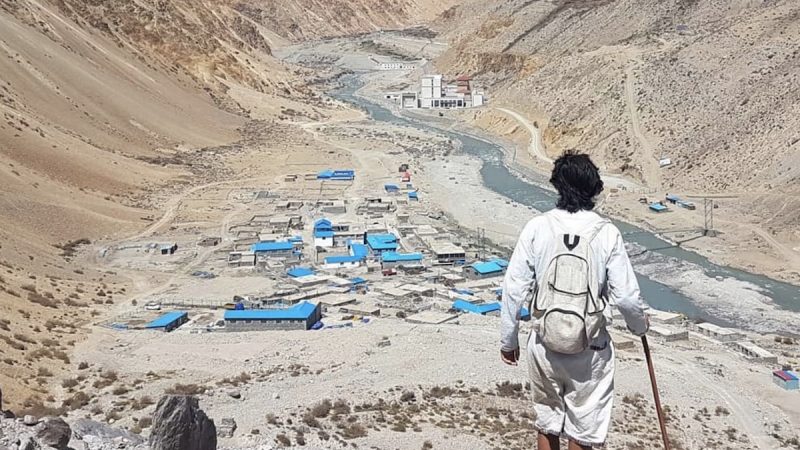 [1]
[1]Iih, the curious traveller turned activist. Photo from Iih's Instagram [2]. Used with permission.
On October 22 [3], 25-year-old Nepalese activist Iih reached the town of Sauraha [4] after walking 167 kilometres for four days from the capital Kathmandu, along with a fellow group of acquaintances. Once there, they distributed supplies to over 75 local families who work in the tourism sector, a major source of revenue in this town, which was badly affected by the COVID-19 pandemic.
This wasn't the first time Iih walked long distances [5] in Nepal, nor the first time he made headlines for his unconventional protest tactics.
Born Ishan Adhikari, Iih dropped out [6] of Kathmandu's prestigious St. Xavier's School at age 14 and set out on walking all over Nepal. In 2015, he walked across the southern plains of Nepal for 37 days [6], covering 1,203 kilometres. Between 2017 and 2018 [7], he travelled across the country from east to west, covering an astounding 6,000 kilometres in 225 days [8]. At some point along his journey, he decided to abandon [9] his birth name, adopting the moniker of Iih.
CK Lal, one of the most read columnists in Nepal, wrote [10] about Iih:
The choice of Ishan's nom de plume is dissent in itself. The word Iih in Nepali stands for “this” and its Sanskrit meaning implies the deity of desire […] a mischievous interpretation of Iih in Nepali is akin to showing the middle finger, probably to the established order of the state and society.
Now enjoying a large social media following [1], Iih first became known in Nepal in 2016, when he was arrested for splashing red paint [11] on the walls of Singha Durbar [12], Nepal's government seat, in protest against police violence.
This year, he turned his tactics towards Nepal's poor COVID-19 response.

Iih being taken to a press conference on August 9, 2020. Photo by Sanjib Chaudhary. Used with permission.
Nepal registered more than 170,000 COVID-19 infections [13] as of November 2. The highest single-day spike in cases took place on October 10 [14] and October 21 [15], with over 5,000 new cases registered each day.
Iih has been critical of the government's response to the pandemic since Nepal declared a nationwide lockdown in March [16]. At that time, the government had been testing suspect COVID-19 cases with RDTs [17], which are less effective in detecting the SARS-CoV-2, and only carrying out PCR tests after a positive RDT sample.
Iih then organized the #EnoughIsEnough campaign, which staged several protests nationwide [18] since June [19]. The campaign demanded expansion of testing [20], discontinuance of RDTs, the rectification of quarantine strategy, transparency and accountability regarding the use of COVID-19-related funds, protection of frontline workers, relief for vulnerable populations, among other issues.
Talking to OnlineKhabar [18], Iih said:
… I posted a story on Instagram, asking, “If anyone wants to come to the street, send me your Facebook ID, I will make a Facebook group and add you.”
About 400 youth sent their IDs saying that they are ready to come to the streets. […]
So, before I did anything, those 400 started inviting other friends to the group called ‘Enough is Enough’.
Iih was arrested in one of the #EnoughIsEnough protests in June:
Nepal Police arrested Ishan along with two others from Maitighar, but hundreds of others continue the protest #EnoughIsEnough [21] #HappeningNow [22] pic.twitter.com/dzfYyUzOPj [23]
— Dewan RAI (@rdewan) June 13, 2020 [24]
This short documentary by Vice Asia documented some of the demonstrations this summer in Nepal:
In June, the always-walking Iih sat down for Satyagraha [25], a form of hunger strike, in protest against the government's COVID-19 measures. He ended the 12-day strike after authorities signed a 12-point agreement with the #EnoughIsEnough campaign pledging to implement a better response.
घरमा बसेर तपाई यसरी #MySatyagraha [26] वा आफ्नै भाषामा #मेरोसत्याग्रह [27] अनी Enough is Enough Nepal लेखेर प्लेकार्ड बनाई फोटो खिची समाजिक सञ्जालमा पेस्ट गरेर पनि तपाईले हाम्रो ‘सरकारलाई कोभिड-१९ को सबल व्यबस्थापन को माग गर्दै’ भईरहेको सत्याग्रह लाई साथ दिन सक्नु हुन्छ ! #EnoughIsEnough [21] pic.twitter.com/jeIOerew7y [28]
— Enough Is Enough Nepal (COVID-19) (@EnoughisEnoughN) June 28, 2020 [29]
You can support the Satyagraha demanding the government for better COVID-19 management staying at home by writing #MySatyagraha in your own language on a placard, clicking a picture of it and posting it on social media.
The #EnoughIsEnough [21] protest & Nepal government’s agreement, signed today: pic.twitter.com/iQGu8Ndscx [30]
— Kashish Das Shrestha (@kashishds) July 7, 2020 [31]
Iih started another Satyagraha [32] on July 17 after the campaign perceived the government had failed to improve its COVID-19 measures. He broke the fast on August 9 [33] after authorities signed another 12-point agreement with the campaign.
Iih continues his journey [34] helping the needy and demanding the government it cares for its citizens.
He writes [35] on his Instagram account:
“How far would I travel
Just to be where you are?
How far is the journey
From here to a star?